2008 JEEP PATRIOT transmission fluid
[x] Cancel search: transmission fluidPage 73 of 438
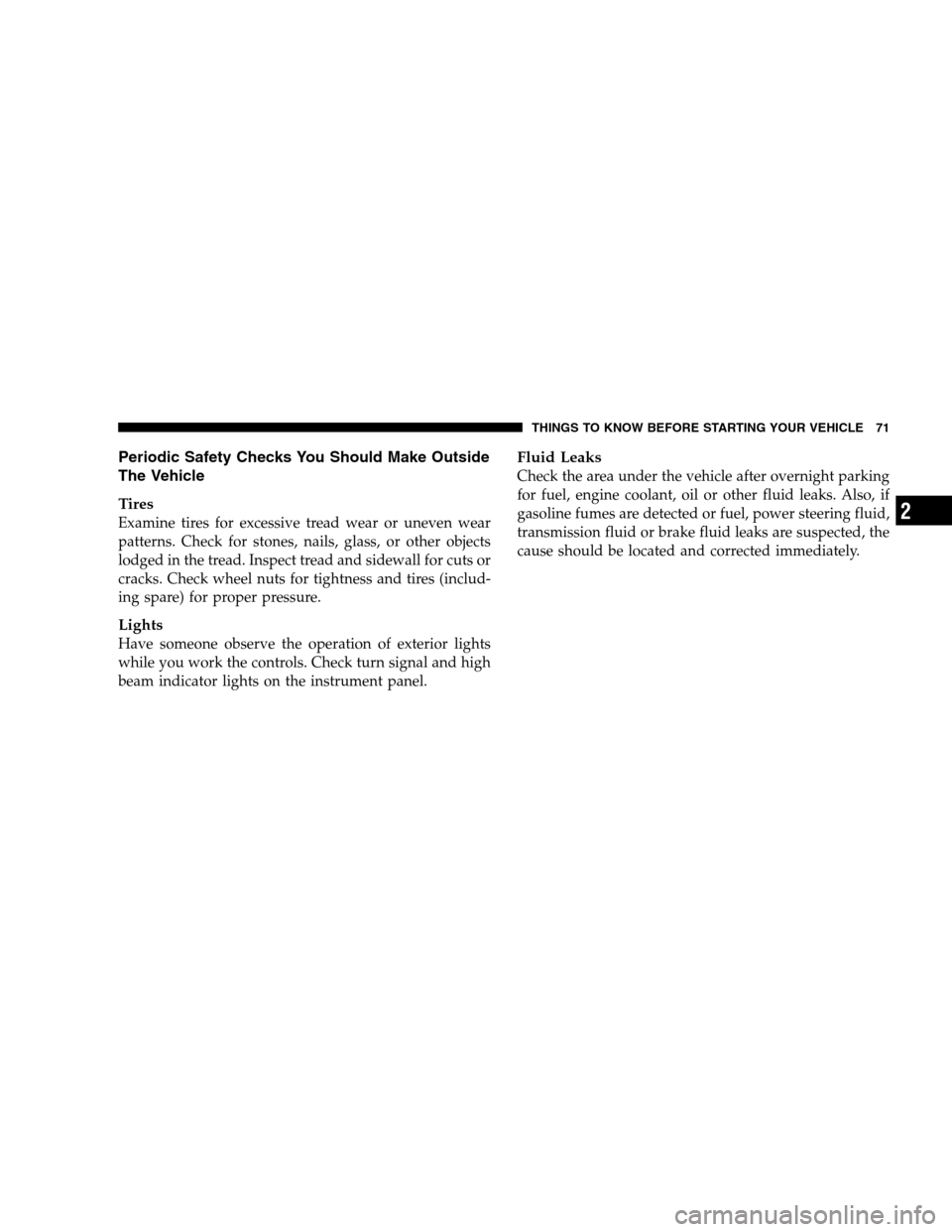
Periodic Safety Checks You Should Make Outside
The Vehicle
Tires
Examine tires for excessive tread wear or uneven wear
patterns. Check for stones, nails, glass, or other objects
lodged in the tread. Inspect tread and sidewall for cuts or
cracks. Check wheel nuts for tightness and tires (includ-
ing spare) for proper pressure.
Lights
Have someone observe the operation of exterior lights
while you work the controls. Check turn signal and high
beam indicator lights on the instrument panel.
Fluid Leaks
Check the area under the vehicle after overnight parking
for fuel, engine coolant, oil or other fluid leaks. Also, if
gasoline fumes are detected or fuel, power steering fluid,
transmission fluid or brake fluid leaks are suspected, the
cause should be located and corrected immediately.
THINGS TO KNOW BEFORE STARTING YOUR VEHICLE 71
2
Page 270 of 438
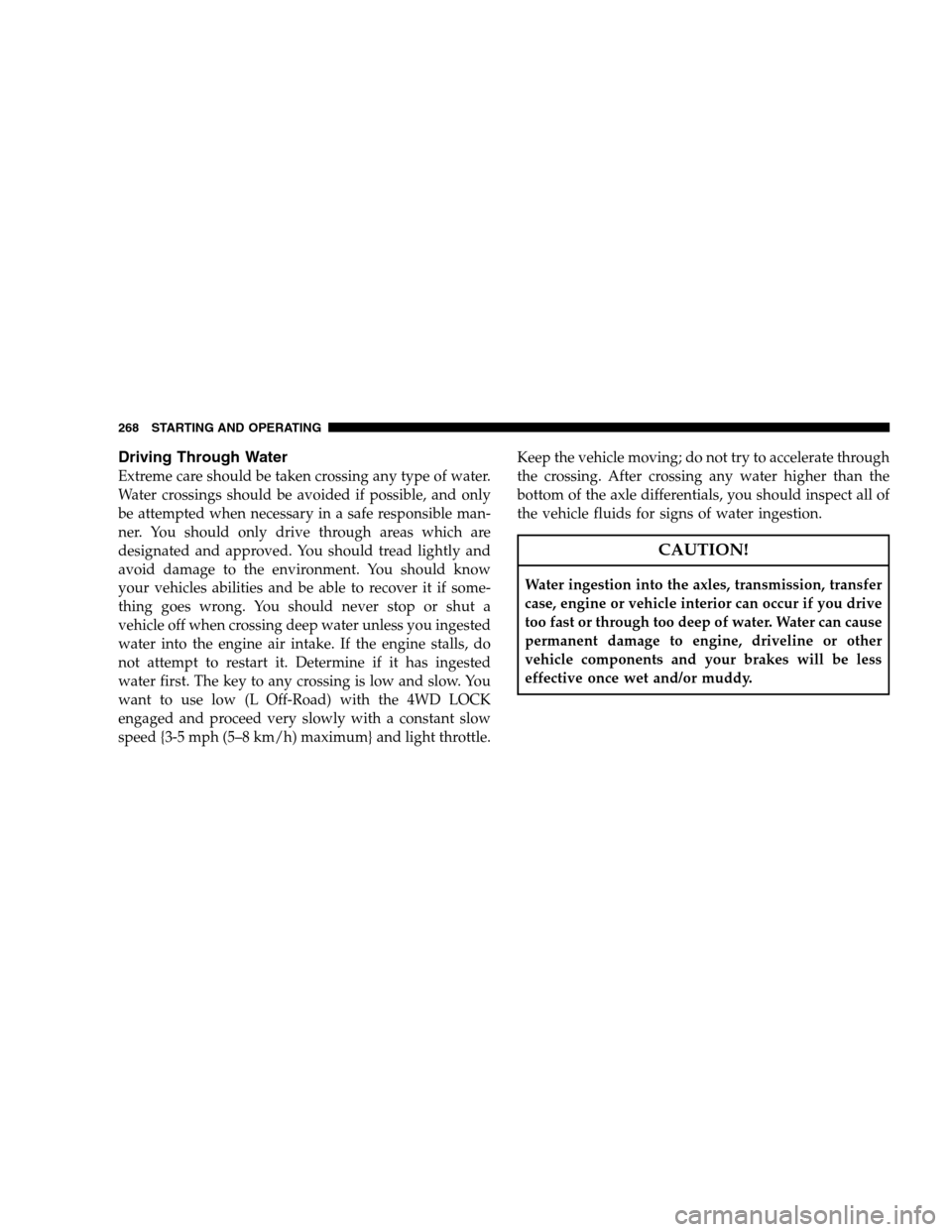
Driving Through Water
Extreme care should be taken crossing any type of water.
Water crossings should be avoided if possible, and only
be attempted when necessary in a safe responsible man-
ner. You should only drive through areas which are
designated and approved. You should tread lightly and
avoid damage to the environment. You should know
your vehicles abilities and be able to recover it if some-
thing goes wrong. You should never stop or shut a
vehicle off when crossing deep water unless you ingested
water into the engine air intake. If the engine stalls, do
not attempt to restart it. Determine if it has ingested
water first. The key to any crossing is low and slow. You
want to use low (L Off-Road) with the 4WD LOCK
engaged and proceed very slowly with a constant slow
speed {3-5 mph (5–8 km/h) maximum} and light throttle.Keep the vehicle moving; do not try to accelerate through
the crossing. After crossing any water higher than the
bottom of the axle differentials, you should inspect all of
the vehicle fluids for signs of water ingestion.
CAUTION!
Water ingestion into the axles, transmission, transfer
case, engine or vehicle interior can occur if you drive
too fast or through too deep of water. Water can cause
permanent damage to engine, driveline or other
vehicle components and your brakes will be less
effective once wet and/or muddy.
268 STARTING AND OPERATING
Page 330 of 438
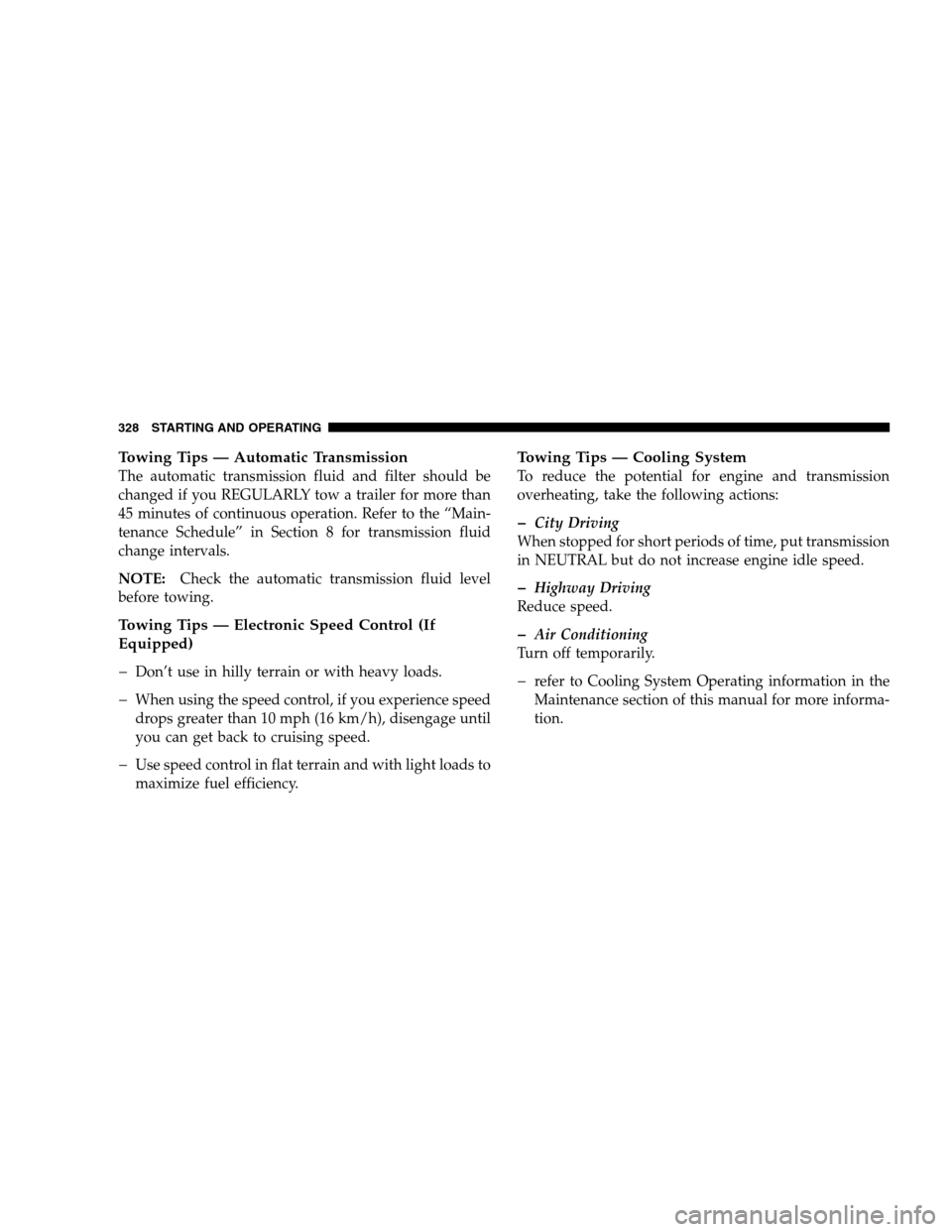
Towing Tips — Automatic Transmission
The automatic transmission fluid and filter should be
changed if you REGULARLY tow a trailer for more than
45 minutes of continuous operation. Refer to the “Main-
tenance Schedule” in Section 8 for transmission fluid
change intervals.
NOTE:Check the automatic transmission fluid level
before towing.
Towing Tips — Electronic Speed Control (If
Equipped)
�
Don’t use in hilly terrain or with heavy loads.
�When using the speed control, if you experience speed
drops greater than 10 mph (16 km/h), disengage until
you can get back to cruising speed.
�Use speed control in flat terrain and with light loads to
maximize fuel efficiency.
Towing Tips — Cooling System
To reduce the potential for engine and transmission
overheating, take the following actions:
�City Driving
When stopped for short periods of time, put transmission
in NEUTRAL but do not increase engine idle speed.
�Highway Driving
Reduce speed.
�Air Conditioning
Turn off temporarily.
�refer to Cooling System Operating information in the
Maintenance section of this manual for more informa-
tion.
328 STARTING AND OPERATING
Page 375 of 438
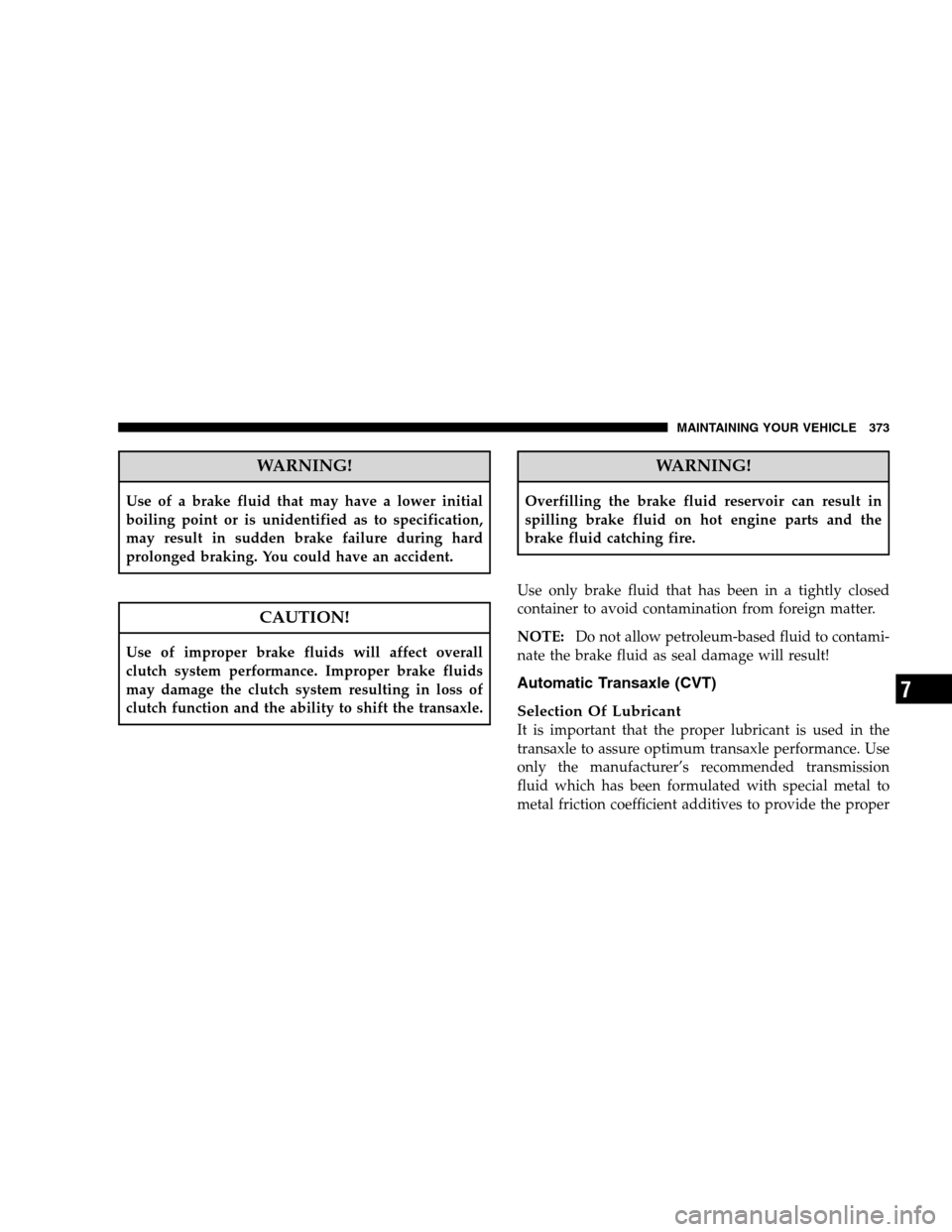
WARNING!
Use of a brake fluid that may have a lower initial
boiling point or is unidentified as to specification,
may result in sudden brake failure during hard
prolonged braking. You could have an accident.
CAUTION!
Use of improper brake fluids will affect overall
clutch system performance. Improper brake fluids
may damage the clutch system resulting in loss of
clutch function and the ability to shift the transaxle.
WARNING!
Overfilling the brake fluid reservoir can result in
spilling brake fluid on hot engine parts and the
brake fluid catching fire.
Use only brake fluid that has been in a tightly closed
container to avoid contamination from foreign matter.
NOTE:Do not allow petroleum-based fluid to contami-
nate the brake fluid as seal damage will result!
Automatic Transaxle (CVT)
Selection Of Lubricant
It is important that the proper lubricant is used in the
transaxle to assure optimum transaxle performance. Use
only the manufacturer’s recommended transmission
fluid which has been formulated with special metal to
metal friction coefficient additives to provide the proper
MAINTAINING YOUR VEHICLE 373
7
Page 376 of 438

steel belt traction on the drive and driven pulleys. Refer
to “Fluids, Lubricants and Genuine Parts” for correct
fluid type.
CAUTION!
Using a transmission fluid other than the manufac-
turer’s recommended fluid will cause belt slip and
result in a complete transmission failure! Refer to
“Fluids, Lubricants, and Genuine Parts” for correct
fluid type.
Fluid Level Check
The fluid level in the automatic transaxle should be
checked only by a trained technician.
Fluid And Filter Changes
Refer to the “Maintenance Schedule” in Section 8 of this
manual for the correct change interval.
Special Additives
Do not add any materials (other than leak detection dyes)
to Continuously Variable Transaxle (CVT) Fluid
(CVTF+4). CVTF+4 is an engineered product and its
performance may be impaired by supplemental addi-
tives.
Manual Transaxle
Lubricant Selection
Use only the manufacturers recommended transmission
fluid. Refer to “Fluids, Lubricants, and Genuine Parts”
under Section 8.
Fluid Level Check
Check the fluid level by removing the fill plug. The fluid
level should be between the bottom of the fill hole and a
point not more that 3/16 in (4.7 mm) below the bottom of
the hole.
Add fluid, if necessary, to maintain the proper level.
374 MAINTAINING YOUR VEHICLE
Page 404 of 438

Once a Month
•Check the tire pressure and look for unusual wear or
damage.
•Inspect the battery and clean and tighten the terminals
as required.
•Check the fluid levels of coolant reservoir, brake
master cylinder, power steering and transmission and
add as needed.
•Check all lights and other electrical items for correct
operation.At Each Oil Change
•Change the engine oil filter.
•Inspect the brake hoses and lines.
•Check the manual transmission fluid level.
CAUTION!
Failure to perform the required maintenance items
may result in damage to the vehicle.
402 MAINTENANCE SCHEDULES
8
M
A
I
N
T
E
N
A
N
C
E
S
C
H
E
D
U
L
E
S
Page 406 of 438
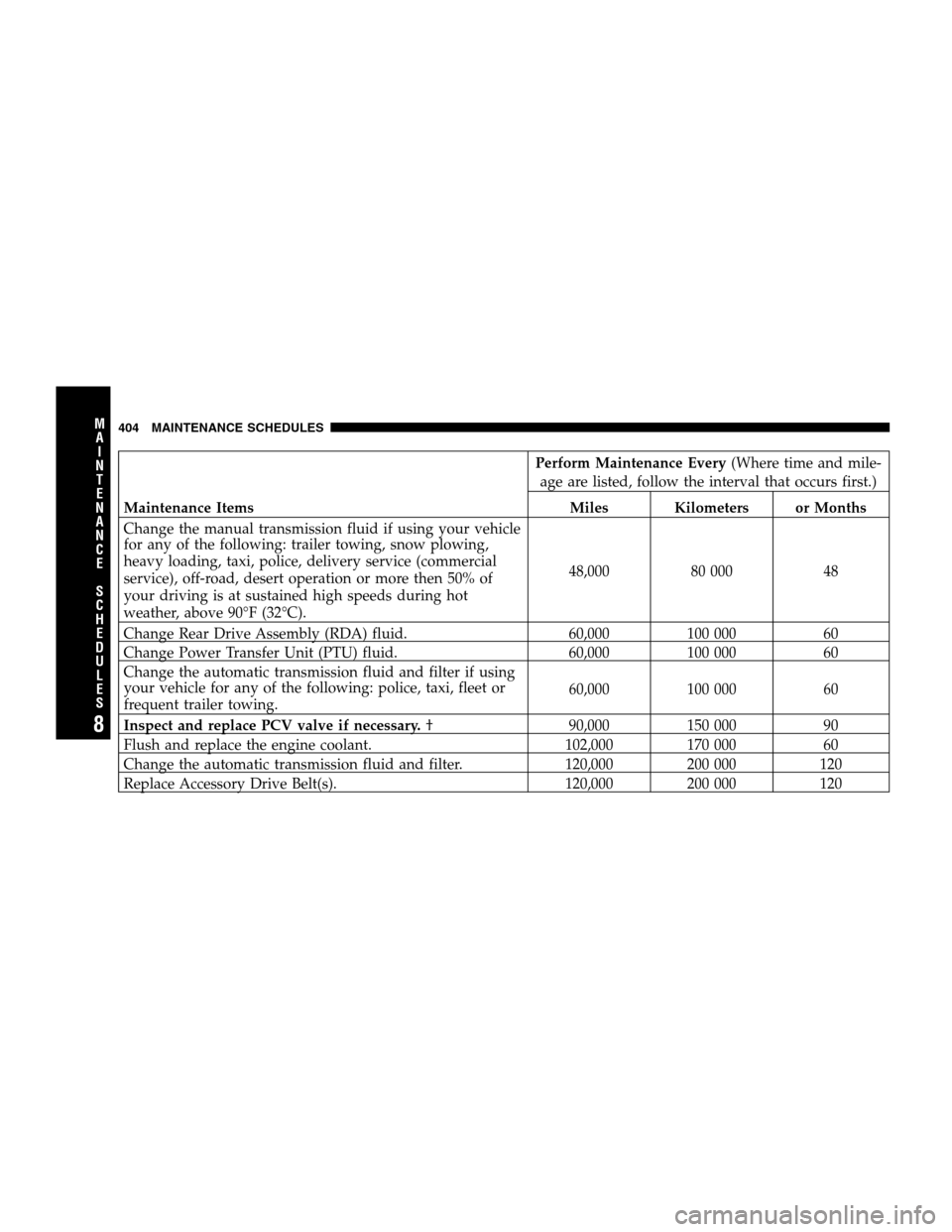
Perform Maintenance Every(Where time and mile-
age are listed, follow the interval that occurs first.)
Maintenance Items Miles Kilometers or Months
Change the manual transmission fluid if using your vehicle
for any of the following: trailer towing, snow plowing,
heavy loading, taxi, police, delivery service (commercial
service), off-road, desert operation or more then 50% of
your driving is at sustained high speeds during hot
weather, above 90°F (32°C).48,000 80 000 48
Change Rear Drive Assembly (RDA) fluid. 60,000 100 000 60
Change Power Transfer Unit (PTU) fluid. 60,000 100 000 60
Change the automatic transmission fluid and filter if using
your vehicle for any of the following: police, taxi, fleet or
frequent trailer towing.60,000 100 000 60
Inspect and replace PCV valve if necessary.† 90,000 150 000 90
Flush and replace the engine coolant. 102,000 170 000 60
Change the automatic transmission fluid and filter. 120,000 200 000 120
Replace Accessory Drive Belt(s). 120,000 200 000 120
404 MAINTENANCE SCHEDULES
8
M
A
I
N
T
E
N
A
N
C
E
S
C
H
E
D
U
L
E
S
Page 421 of 438
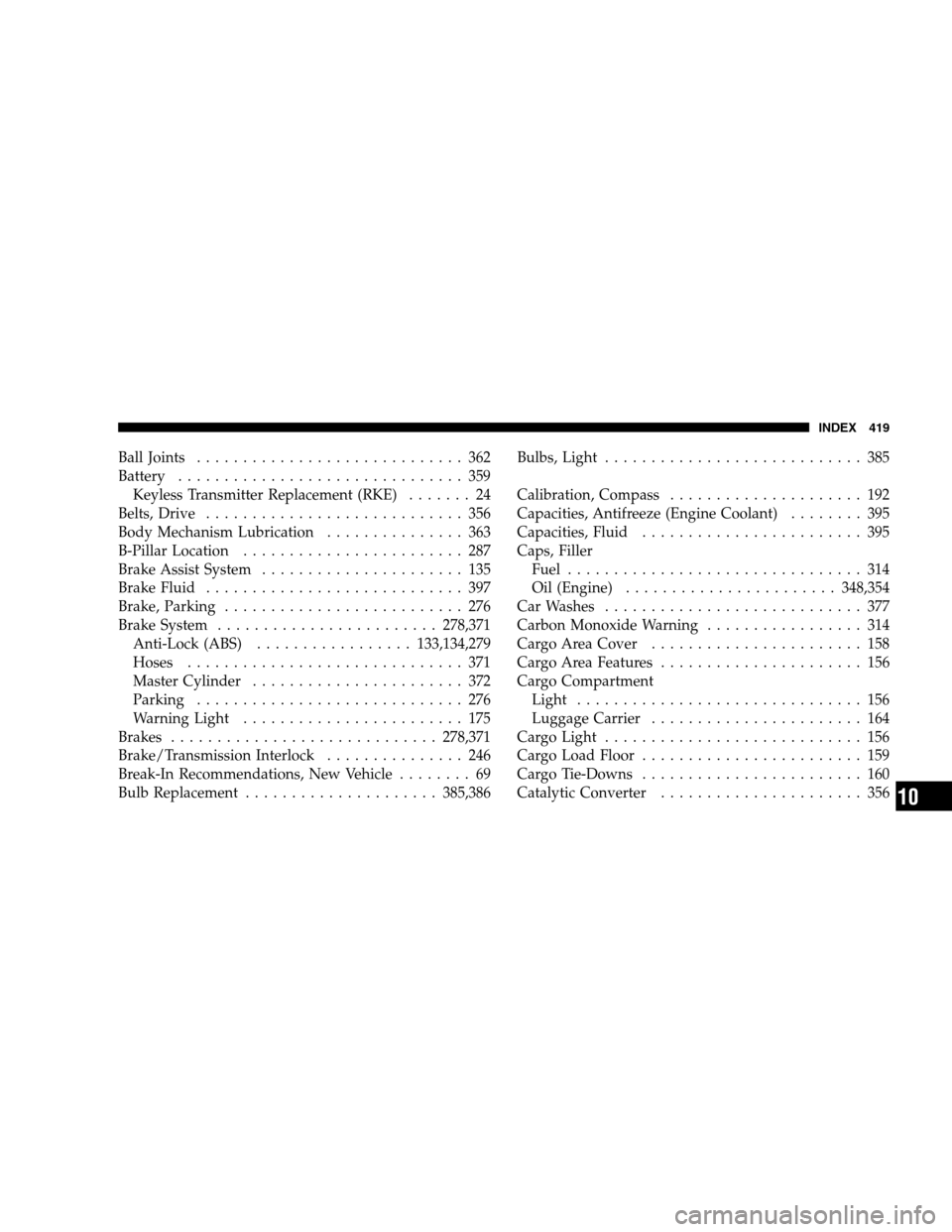
BallJoints ............................. 362
Battery............................... 359
Keyless Transmitter Replacement (RKE)....... 24
Belts,Drive ............................ 356
Body Mechanism Lubrication............... 363
B-Pillar Location........................ 287
Brake Assist System...................... 135
Brake Fluid............................ 397
Brake, Parking.......................... 276
Brake System........................278,371
Anti-Lock (ABS).................133,134,279
Hoses.............................. 371
Master Cylinder....................... 372
Parking............................. 276
Warning Light........................ 175
Brakes.............................278,371
Brake/Transmission Interlock............... 246
Break-In Recommendations, New Vehicle........ 69
Bulb Replacement.....................385,386Bulbs,Light ............................ 385
Calibration, Compass..................... 192
Capacities, Antifreeze (Engine Coolant)........ 395
Capacities, Fluid........................ 395
Caps, Filler
Fuel................................ 314
Oil (Engine).......................348,354
Car Washes............................ 377
Carbon Monoxide Warning................. 314
Cargo Area Cover....................... 158
Cargo Area Features...................... 156
Cargo Compartment
Light ............................... 156
Luggage Carrier....................... 164
CargoLight ............................ 156
Cargo Load Floor........................ 159
Cargo Tie-Downs........................ 160
Catalytic Converter...................... 356
INDEX 419
10